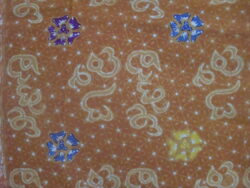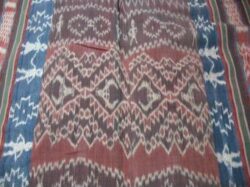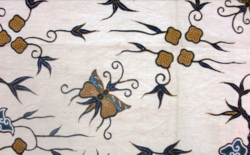The Coleman Collection of Indonesian Textiles
The Coleman Collection of Indonesian Textiles forms part of the International Textiles Collection (ITC) which itself is one of the Brotherton Library’s Special Collections. The Coleman Collection is named after Hywel Coleman, Honorary Senior Research Fellow at the School of Education, University of Leeds.
It is currently on display until 30th August at the Stanley & Audrey Burton Gallery, where you can see the items in person.
'With the addition of the Coleman Collection in 2022, Indonesian textiles within the ITC grew from 94 to 340 items. The University of Leeds now has the third largest collection of Indonesian textiles in the UK, behind only the Horniman Museum in South London and the British Museum.
Range of items
The Coleman Collection was built up over a period of almost 50 years. The items come from across the Indonesian archipelago, from Aceh in the far northwest to Rote Ndao in the far southeast. Its geographical strengths are in textiles from Java, some parts of Sumatra, South Sulawesi, Bali, West Nusa Tenggara, and Timor with other nearby islands in East Nusa Tenggara.
The collection contains multiple examples of the wide variety of textile production and dyeing techniques found in Indonesia. These include batik, ikat and supplementary weft; there are textiles woven on backstrap and shaft looms; and there are examples made with locally grown and imported cotton, plant fibres, local and imported silk and metallic threads. The collection pays particular attention to the functions and meanings of textiles and the social contexts in which they are produced and used.
Four examples illustrate the range of textiles in the collection.
Batik Basurek from Bengkulu
 Batik is now produced not only in Central Java (where it originated) but across Indonesia. This particularly interesting piece comes from Bengkulu in Southwest Sumatra.
Batik is now produced not only in Central Java (where it originated) but across Indonesia. This particularly interesting piece comes from Bengkulu in Southwest Sumatra.
In the Bengkulu language, basurek means ‘bearing letters’. Originally the pattern on batik basurek consisted of Arabic words and letters. However, over time, the ‘writing’ has been deliberately reduced to stylised symbols that show a resemblance to Arabic letters. This came about for fear that cloths inscribed with holy texts (albeit only single letters) might be used for profane purposes. (HC2016.03, ITC 2022.293)
Warp ikat blanket from Rongkong

A cotton blanket in red, blue, green, brown, and white, covered in various motifs including some patterns and human figures.
The cloths produced in Rongkong – a remote village in the mountains between Toraja and Central Sulawesi - have intriguing similarities with warp cloth textiles produced on the island of Sumba and those woven by the Iban in Sarawak.
Research is needed to establish whether these similarities are coincidental or whether there are genetic and/or linguistic links between these three groups. (HC1982.01, ITC2022.6)
Geringsing altar cloth from Bali

A person making a printed altar cloth, hand spinning a red sheet of cotton with a yellow pattern.
Geringsing textiles are celebrated because both their warp and weft threads are pre-dyed before weaving begins.
Producing double ikat is an extremely slow and painstaking task; apart from one village in Bali the process is found only in a village in Japan and two villages in Gujarat.
The resulting textiles are so delicate that they can be used only on special occasions and in special contexts - such as in Bali where they function as altar cloths. (HC2005.15, ITC 2022.43)
Songket from the island of Lombok

A woven Balinese saput or kampuh, an outer hip cloth for men. Made with gold metallic thread over black and white, creating a rich background with a raised pattern.
Songket are cloths in which metallic threads are introduced into the weaving process. The beautiful end product shimmers as its wearer moves. The metallic thread makes the textiles heavy – and expensive. Songket are found in different parts of the country and there are several in the collection.
This example is a saput, a man’s outer hip cloth used by the Sasak people of Lombok in wedding ceremonies and other special occasions. It illustrates the influence of Balinese culture in west Lombok. (HC1973.05, ITC2022.2)
The future of the collection
In 2008 an exhibition, ‘The Textiles of Bali and Nusa Tenggara’, drawing on the Coleman Collection, took place in the International Textile Archive. A further exhibition, possibly focussing on batik, is planned.
At the time of writing, the Coleman Collection is being catalogued. It is hoped that the process will be completed by May 2024 and that the catalogue will be freely accessible online.
While recognising that the ITC’s storage capacity is limited, Hywel continues to collect. In 2022 he visited the Sultanates of Ternate and Tidore in North Maluku to investigate traditional textile production on the islands and was able to acquire two new items. The most recent acquisitions are a siga (man’s hat from Central Sulawesi) and a selempang (very large woven blanket, used as a shoulder cloth, from South East Sulawesi).


